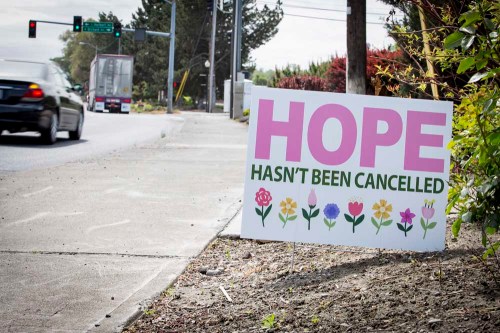Mental health lines deal with deluge of calls in the midst of COVID-19
Published 5:00 am Saturday, May 2, 2020

- A sign along Highway 395 in Hermiston advises drivers to remain hopeful amidst the current COVID-19 pandemic.
PENDLETON — The double whammy of COVID-19 and a distressed economy has some mental health experts worrying about America’s suicide rate.
Some predict that suicide rates will rise higher. Callers are deluging help lines to talk about their anxieties.
“We’ve had a huge uptick in calls,” said Sharon Kuehn, manager of the David Romprey Oregon Warmline. “We were averaging 85 to 120 calls a day — now we’re taking 300 calls a day.”
Most callers mention COVID, Kuehn said. People are lonely, isolated, afraid and anxious, and worried about their finances, jobs and health.
Greg Borders, chief clinical officer for Portland-based nonprofit Lines for Life, said the organization’s help lines (Alcohol & Drug Helpline, Military Helpline, Youthline and the Senior Loneliness Line) got from 20% to 34% more calls in the past month. Callers share anxieties about health, finances, job loss and the stress of isolation, among other fears and worries.
“COVID may not be the primary reason for the call, but it is in the context of everything,” Borders said. “We’re hearing COVID mentioned in just about every call.”
All those anxieties aren’t necessarily translating into a higher suicide rate. Clinicians manning the 24-hour crisis line at Lines for Life are answering about the same volume of calls as last month.
“The suicide line has remained pretty flat while the others have increased pretty significantly,” said Lines for Life CEO Dwight Holton. “I think what’s going on is people are at home with friends and family. People are checking in with their high school buddy they haven’t talked to in years. They’re checking in on Mom and Dad and their elderly neighbors to see if they need anything. There’s a level of hope. These connections are helping address the underlying anxiety.”
No one truly really knows what will happen until it happens. Kimberly Lindsay, CEO of Heppner-based Community Counseling Solutions, which provides mental health care for four Eastern Oregon counties, said a spike in the suicide rate isn’t a foregone conclusion, but she believes public health agencies like hers need to prepare for the likelihood.
“I think history is the best predictor of the future,” Lindsay said. “You only have to look back to history to get a flavor of what’s to come. There is a strong correlation between suicide and the economy. There’s a strong correlation between suicide and unemployment.”
So far 30 million Americans have lost their jobs during the pandemic. Since March 15, the Oregon Employment Department received more than 362,200 initial claims for unemployment insurance. Lindsay pointed to research showing increasing suicide after significant economic contractions, such as the Great Recession of the late 2000s and the stock market crash in 1929 that led to the Great Depression, and neither of those economic crashes were paired with a global pandemic.
“I am super concerned,” Lindsay said. “You are going to have deaths attributable to coronavirus. You are going to have people with health conditions that went untreated due to fear and anxiety of accessing health care. You’ll have homelessness and hunger.”
And an uptick in suicide? An article this month in JAMA Psychiatry suggested the pandemic brings together a perfect storm of risk factors that include economic stress, isolation and increased gun sales.
Some police departments are reporting more suicide-related calls.
Portland Police Chief Jamie Resch said in a news conference that his department saw a 41% increase in 911 calls related to suicide attempts or threats compared with 2019, and 23% higher compared to the 10 days before the state of emergency. He urged people to reach out to family, friends and neighbors via text, phone or video chat.
Pendleton Police Chief Stuart Roberts said the number of calls for service concerning individuals displaying or communicating suicidal tendencies remains fairly static so far, but he knows of three deaths by suicide in the last couple of months.
“On an annual basis, we may see as many as a half dozen,” Roberts said.
Roberts added that none of the recent suicides appears to be COVID-related, but rather seemed motivated by medical conditions. He won’t ever know for sure if coronavirus factored in.
Hermiston Police Chief Jason Edmiston said March showed a 67% reduction in suicide-related calls from last March, but mental health calls rose 60%. For the April report, he predicted a rise in calls related to domestic violence, mental health and suicide. He knows of one recent suicide in the county where the person had commented about the economic shutdown before dying by self-inflicted gunshot. And as Edmiston answered questions about mental health calls, some of his officers were searching for a person whose probation officer had reported as suicidal.
“The longer this draws out, the higher the numbers could be,” Edmiston said.
Health care workers are more at risk for suicide than the general population in the best of times. Coronavirus presents new challenges. In one high-profile case, an emergency room doctor who treated many coronavirus patients at Manhattan’s New York-Presbyterian Allen Hospital died by suicide on April 26. Dr. Lorna M. Breen, 49, had recovered from the virus and gone back to work.
Suicide is a daunting topic. Lindsay said her organization embraced a strategy called Zero Suicide about two years ago and has since been working through all the steps.
“It is an evidence-based approach to getting serious about suicide,” she said. “Zero Suicide infiltrates every layer of an organization from maintenance to the board of directors. You are going to train every employee on how to have a meaningful conversation with someone who is feeling down. Eventually, we will broaden out to include the entire community and encourage them to be on the same page.”
The arrival of coronavirus added more urgency and requires creativity.
“We have already been working on Zero Suicide but COVID is another layer in the onion,” she said. “To identify suicide risk, you have to be nimble and responsive. How do you do screening without people coming through your front door? You have to adapt.”
The organization planned to give community partners QPR (question, persuade, refer) training in two-hour in-person sessions. Now they may go online. Lindsay believes everyone should learn how to talk with people in their lives who seem depressed.
“People resist getting involved with someone who is depressed,” she said. “They say, ‘What if I say the wrong thing? What if I upset them?’ You don’t have to be Einstein to do this. You ask a few questions. You persuade and you refer.”
Lindsay hopes for the best, but doesn’t mince words.
“I’m really concerned,” she said. “We are going to see a fallout from a mental health perspective.”









